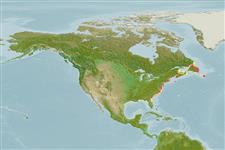Common names from other countries
Classification / Names / Names
Nomi Comuni | Sinonimi | Catalog of Fishes (gen., sp.) | ITIS | CoL | WoRMS
Environment: milieu / climate zone / depth range / distribution range
Ecologia
; distribuzione batimetrica 11 - 16 m (Ref. 1239). Subtropical
Western Atlantic: USA and Canada. Tropical to polar climates of northern hemisphere.
Length at first maturity / Size / Peso / Age
Maturity: Lm ? range ? - ? cm Max length : 0.2 cm TL maschio/sesso non determinato; (Ref. 1239); common length : 0.1 cm TL maschio/sesso non determinato; (Ref. 1239)
Found in the littoral zone. Active hunter (Ref. 111265).
Life cycle and mating behavior
Maturità | Riproduzione | Deposizione | Uova | Fecundity | Larve
Members of the class Aplacophora are mostly hermaphroditic. Life cycle: Eggs hatch into lecitotrophic larvae which later develop into adults.
Morse, M.P. and J.L. Norenburg. 1992. (Ref. 1239)
IUCN Red List Status (Ref. 130435)
CITES status (Ref. 108899)
Not Evaluated
Not Evaluated
Threat to humans
Harmless
Human uses
| FishSource |
Strumenti
Informazioni ulteriori
Age/Size
Accrescimento
Length-weight
Length-length
Morfologia
Larve
Abbondanza
Fonti Internet
Estimates based on models
Preferred temperature
(Ref.
115969): 3.1 - 23.7, mean 7.2 (based on 168 cells).
Vulnerability
Low vulnerability (10 of 100).
Price category
Unknown.
